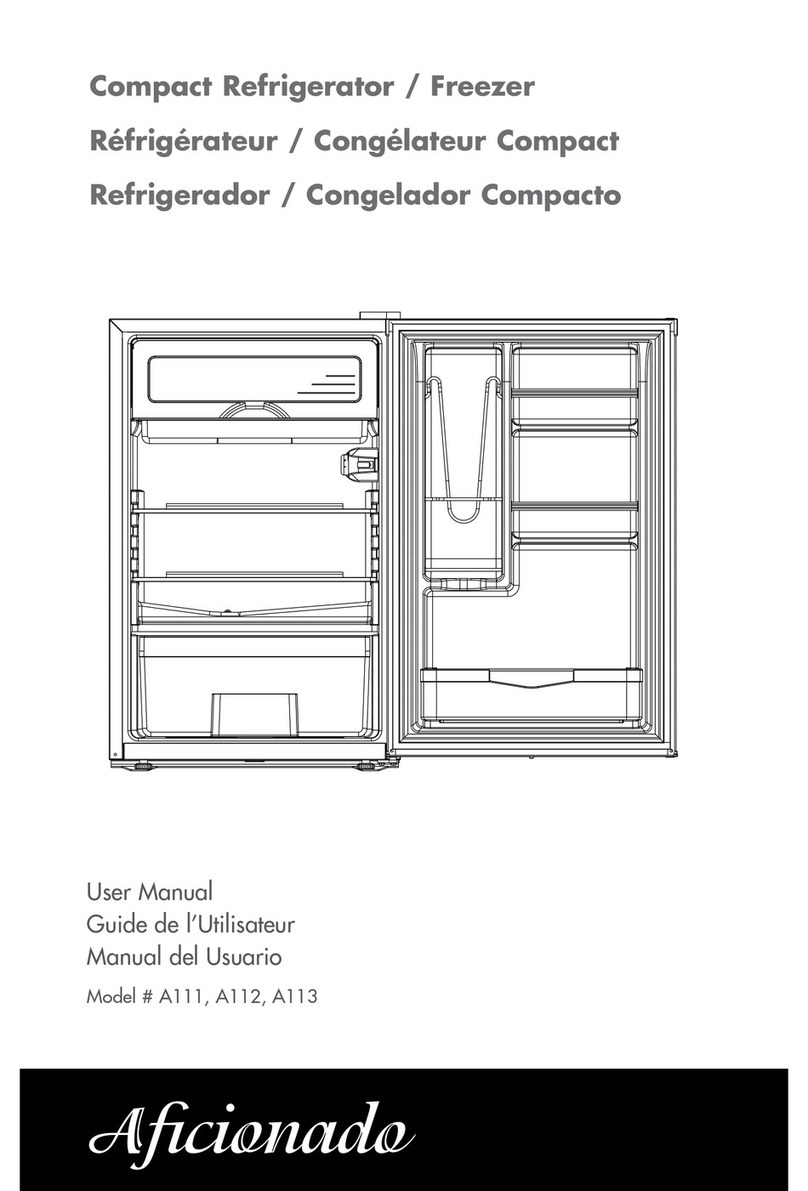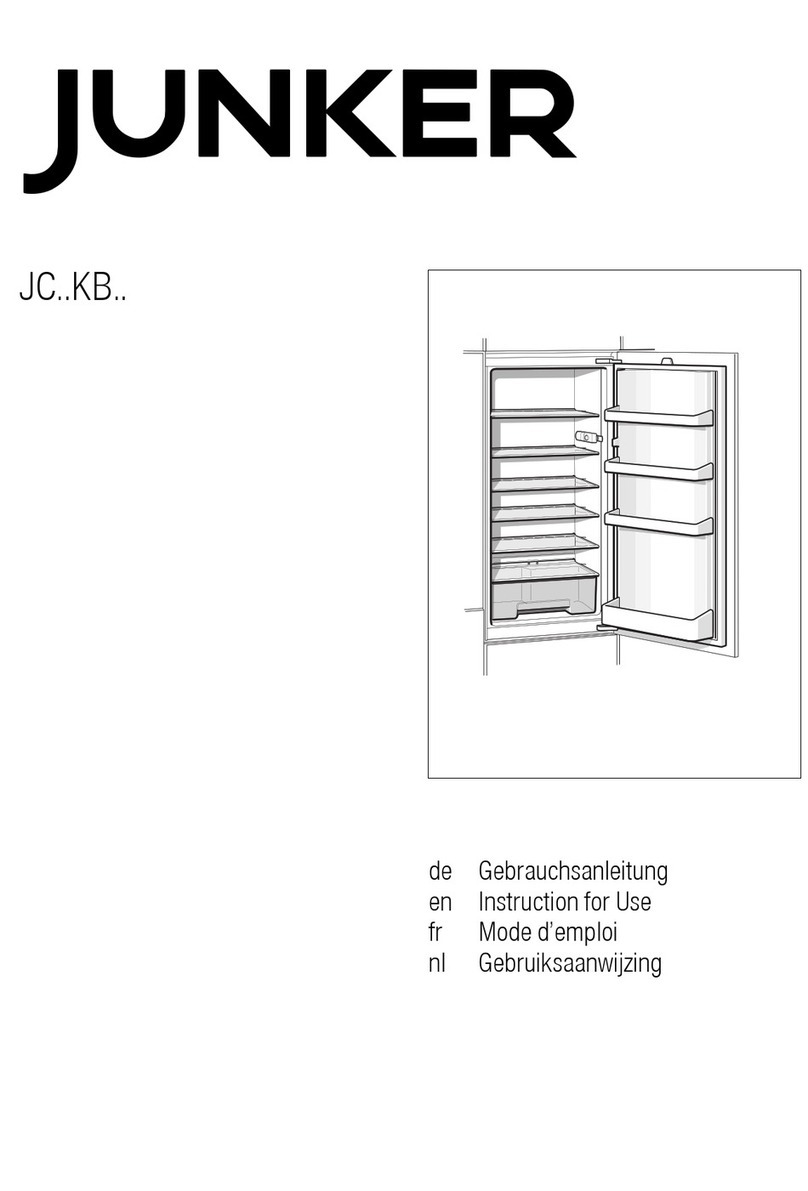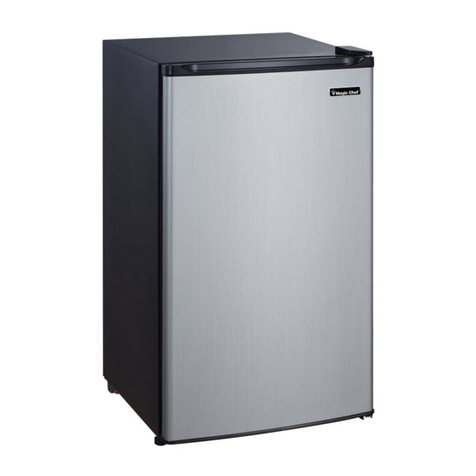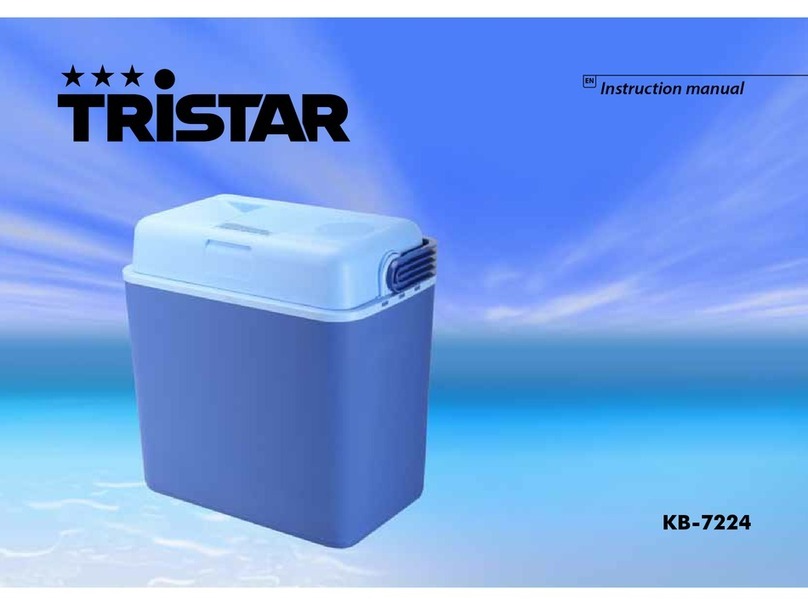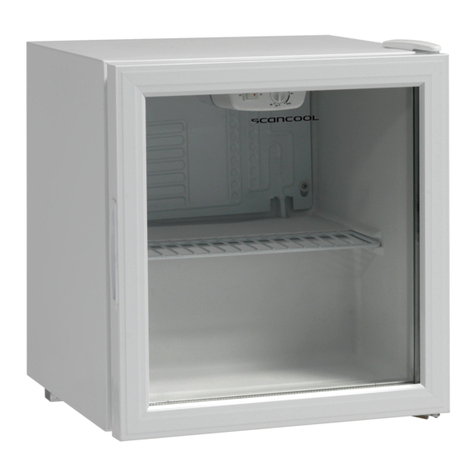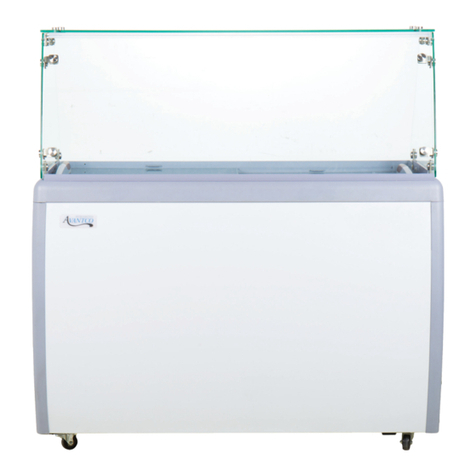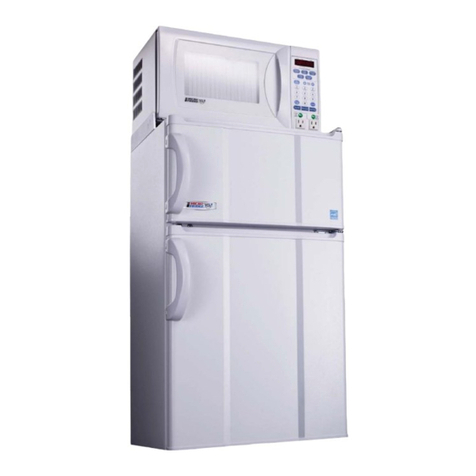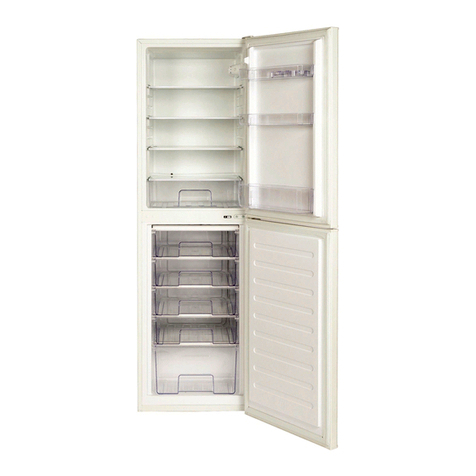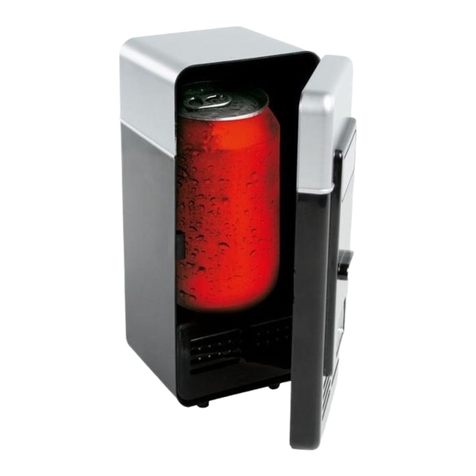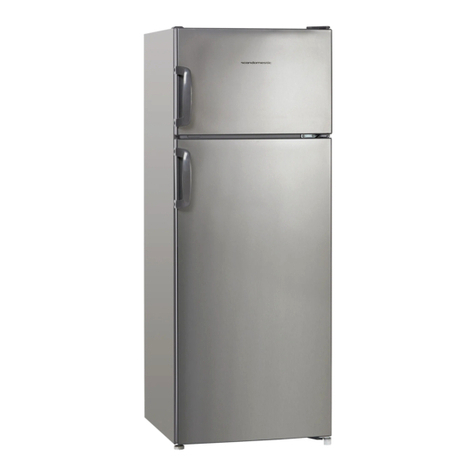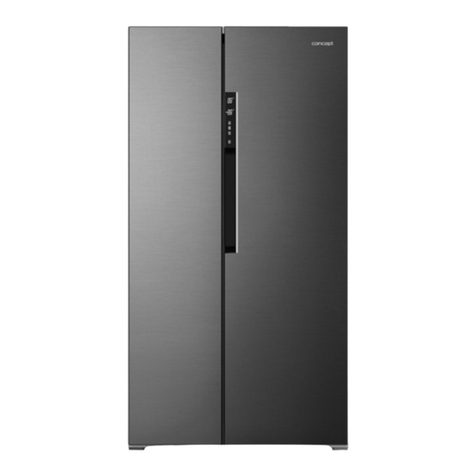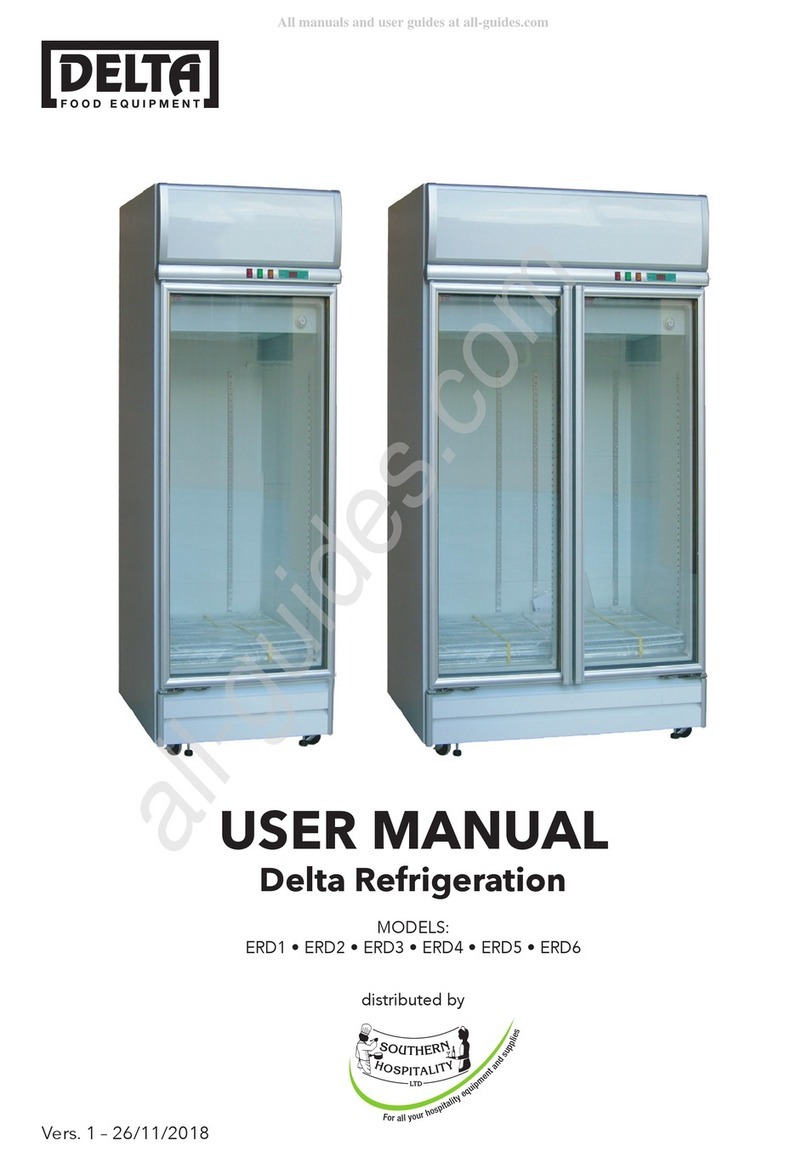Aficionado M14 User manual

Two-Door Frost Free Refrigerator
Le Manuel de Deux Portes Dégivrent le
Réfrigérateur
El Manual de Dos Puertas Descongela el
Refrigeradore
User Manual (Features may vary by model)
Model # M14, M15, M16
Guide de l’Utilisateur (Les caractéristiques Peuvent Varier par le Modéle)
Modéle # M14, M15, M16
Manual del Usuario (Las caracteristicas Pueden Variar por el Modelo)
Para Modelo de # M14, M15, M16

SAFETY PRECAUTIONS
Read all of the instructions before using this appliance. When using this
appliance, always exercise basic safety precautions, including the
following:
1) Use this appliance only for its intended purpose as described in this use
and care guide.
2) This refrigerator must be properly installed in accordance with the
installation instructions before it is used. See grounding instructions in the
installation section.
3) Never unplug your refrigerator by pulling on the power cord. Always
grasp the plug firmly and pull straight out from the outlet.
4) Repair or replace immediately, all electric service cords that have become
frayed or otherwise damaged. Do not use a cord that shows cracks or
abrasion damage along its length, the plug or the connector end.
5) Unplug your refrigerator before cleaning or before making any repairs.
Note: If for any reason this product requires service, we strongly
recommend that a certified technician performs the service.
6) Do not use any electrical device or any sharp instrument in defrosting your
refrigerator.
7) If your old refrigerator is not being used, we recommend that you remove
the doors and leave the shelves in place. This will reduce the possibility of
danger to children.
8) After your refrigerator is in operation, do not touch the cold surfaces in
the freezer compartment, particularly when hands are damp or wet. Skin
may adhere to these extremely cold surfaces.
9) Do not refreeze foods which have been thawed completely. The United
States Department of Agriculture in Home and Garden Bulletin No. 69
reads: "…You may safely refreeze frozen foods that have thawed if they
still contain ice crystals or if they are still cold-below 40˚F".
"…Thawed ground meats, poultry, or fish that have any off-odor or
off-color should not be refrozen and should not be eaten. Thawed ice
cream should be discarded. If the odor or color of any food is poor or
questionable, discard it. The food may be dangerous to eat."
"…Even partial thawing and re-freezing reduce the eating quality of
foods, particularly fruits, vegetables, and prepared foods. The eating
quality of red meats is affected less than that of many other foods. Use
refrozen foods as soon as possible, to save as much of its eating quality
as you can."
1
English

2
Thank you for using our Haier
product. This easy-to-use manual will
guide you in getting the best use of
your refrigerator.
Remember to record the model and
serial number. They are on a label in
back of the refrigerator.
Model number
Serial number
Date of purchase
Staple your receipt to your manual. You will need it to obtain
warranty service.
10) This refrigerator should not be recessed or built-in in an enclosed
cabinet. It is designed for freestanding installation only.
11) Do not operate your refrigerator in the presence of explosive fumes.
SAVE THESE INSTRUCTIONS
for future use
DANGER
Risk of child entrapment. Before you throw away your old
refrigerator or freezer, take off the doors. Leave the shelves
in place so that children may not easily climb inside.
English

3
Table Of Contents
PAGE
Safety Precautions...........................................................................1
Parts And Features..........................................................................4
Installing Your Refrigerator ...........................................................5
Unpacking Your Refrigerator...................................................................5
Adjusting Your Refrigerator.....................................................................5
Proper Air Circulation ............................................................................5
Electrical Requirements ...........................................................................6
Door Alignment .....................................................................................7
Reversing the Door Swing.......................................................................8
Refrigerator Features And Use .................................................. 10
General Features................................................................................. 10
Refrigerator Interior Shelves................................................................. 10
Crisper and Crisper Cover................................................................... 11
Food Storage Information .................................................................... 12
Normal Operating Sounds................................................................... 13
Proper Refrigerator Care and Cleaning ................................... 14
Cleaning and Maintenance.................................................................. 14
Light Bulb Replacement........................................................................ 15
Power Interruptions ............................................................................. 15
Vacation and Moving Care.................................................................. 15
Troubleshooting............................................................................. 16
Warranty Information.................................................................. 18
English

Parts And Features
4
English
1. Ice Cube Trays
2. Full-Width Freezer Door Shelves
3. Full-Width Door Shelf
4. Adjustable Front Leveling Legs
(not shown)
5. Clear Crisper
6. Clear Glass Crisper Cover
7. Adjustable Full-Width Wire Shelves
(number will vary by model)
8. Adjustable Mechanical
Temperature Control
9. Interior Light
10. Freezer Shelf
11. Gallon Storage Compartment
12. Can Storage (not on all models)
13. 1/2 Width Shelf Storage
Compartment (not on all models)
14. Half-Width Shelf, 2 Liter Bottle
Storage Compartment
15. Crisper Humidity Control
16. Air Flow Control
17. Condiments Storage Shelf
(M16 ONLY)
(Features may vary per model)
1
2
3
4
5
6
7
8
9
10
11
12
13
14
15
16
17

1. Remove all packaging material. This includes the foam base and
all adhesive tape holding the refrigerator accessories inside an
outside. Slide out and remove plastic or foam guard used to
secure the compressor from shipping damage due to vibration
and shock.
2. Inspect and remove any remains of packing, tape or printed
materials before powering on the refrigerator.
Leveling Your Refrigerator:
• Your refrigerator has two leveling legs which are located in the
front corners of your refrigerator. After properly placing your
refrigerator in its final position, you can level your refrigerator.
• Leveling legs can be adjusted by turning them counterclockwise to raise
your refrigerator or by turning them clockwise to lower
your refrigerator. The refrigerator door will close easier when the
leveling legs are raised.
• To ensure that your refrigerator works at the maximum efficiency it was
designed for, you should install it in a location where there is proper air
circulation, plumbing and electrical connections.
• The following are recommended clearances around the
refrigerator:
Sides……………3/4 "(19mm)
Top....................1" (25mm)
Back..................1" (25mm)
Installing Your Refrigerator
Unpacking Your Refrigerator
Adjusting Your Refrigerator
Proper Air Circulation
5
English

Electrical Requirement
• Make sure there is a suitable power outlet (115 volts, 15 amps outlet) with proper
grounding to power the refrigerator.
• Avoid the use of three-plug adapters or cutting off the third grounding in order to
accommodate a two-plug outlet. This is a dangerous practice since it provides no
effective grounding for the refrigerator and may result in shock hazard.
• Do not install your refrigerator in any location not properly insulated or heated,
e.g. garage etc. Your refrigerator was not designed to operate in temperature
settings below 55˚ Fahrenheit.
• Select a suitable location for the refrigerator on a hard, even
surface away from direct sunlight or heat source, e.g. radiators,
baseboard heaters, cooking appliances etc. Any floor unevenness should be
corrected with the leveling legs located on the front bottom corners of the
refrigerator.
Installation Limitations
6
English

Freezer Door: (see fig. # 1)
1. Remove hinge cover screw.
2. Remove the top hinge cover.
3. Loosen the top hinge screws using a Phillips head screwdriver.
4. Adjust the door or put a spacer in between and then tighten the screws.
5. Replace the top hinge cover.
Door Alignment
7
English
Hinge box
cover
Top hinge
lower bracket
lower pivot pin
lower pivot pin hole
bottom hinge pad
Hinge box
cover
Top hinge
lower bracket
lower pivot pin
lower pivot pin hole
bottom hinge pad
Refrigerator Door:
1. Loosen and remove the bottom hinge using a Phillips head screwdriver.
2. Adjust the door, or put a spacer between and then tighten the screws.
Fig. #1
Fig. #2

8
English
Reversing the Door Swing
Left/right door opening method:
This product allows you to reverse the door opening from left to right and back. You
can select your preference of door opening by following the procedure to make the
change.
Dismantling:
1. Affix refrigerator and freezer door by sticking adhesive tape on both sides to hold
doors in place.
2. As shown in Fig #1, dismantle the hinge box cover on the upper part of freezer
door with a Phillips head screwdriver. Then remove the three screws from the
hinge. Take out the hinge by pulling it vertically, and keep it in a safe place.
3. Remove the adhesive tape on freezer door, lift and take the door down, and
carefully put it aside.
4. Dismantle two screws of the central hinge, lift and take down the central hinge,
and keep them in a safe place. (See Fig #3)
5. Remove the adhesive tape on refrigerator door, lift and take down refrigerator
door, and carefully put it aside.
6. Remove the door stoppers from the freezer and refrigerator doors and install them
on the opposite side of the door. (Not on all Models).
screw holes
stop of freezer door (Not on all Models)
middle pivot pin
stop of refrigerator door (Not on all Models)
middle bracket
(central hinge bracket)
fig. # 3

9
English
Reinstallation:
(See Fig #4 and Fig #5)
1. Remove the lower pivot pin from the braket of the lower hinge by turning cunter
clockwise. Move the pin to the opposite hold and tighten.
2. Loosen the screws holding the lower hinge braket and remove the hinge.
3. Align the holes in the lower hinge braket to the corresponding holes in the
opposite side of the cabinet. Insert and tighten the screws.
4. To install refrigerator door: make the left bottom hole of the refrigerator
compartment door fall over the lower hinge axle, move the door forward to make
it straight and in alignment with cetral hinge. Install the central hinge again, turn
the hinge axle until it completely enters the door body, then fix it with screws.
5. To install freezer door: make the left bottom hole of freezer door fall over teh
central hinge axle; raise upper hinge, so that hinge axle can be installed in the
upper hole of the upper part of the freezer door; adjust door to make it straight
and level.
6. As shown in Fig #1, install the upper freezer hinge to the left corresponding
postiion. (Tighten the screws of upper hinge).
7. Replace the hinge cover as shown in Fig #1.
lower bracket
lower pivot pin
bottom hinge pad
lower pivot pin hole
stop of freezer door
(Not on all Models)
middle pivot pin
middle bracket
(central hinge bracket)
screw holes
stop of refrigerator door
(Not on all Models)
lower bracket
lower pivot pin
bottom hinge pad
lower pivot pin hole
stop of freezer door
(Not on all Models)
middle pivot pin
middle bracket
(central hinge bracket)
screw holes
stop of refrigerator door
(Not on all Models)
Fig. #4
Fig. #5

10
Refrigerator Features And Use
The refrigerator shelves of your refrigerator were designed with you in mind.
Their varied adjustability allows you to satisfy your personal storage needs.
To remove or adjust a full-width
slide-out shelf: (see fig. # 5)
1. Gently tilt the shelf up and slide forward until the shelf has been completely
removed.
2. To replace the shelf, select the desired setting and gently slide the shelf back
until it rests in the locking position.
General Features
Adjustable temperature dial:
Your refrigerator will automatically
maintain the temperature level you
select. The temperature control dial has
7 settings plus off. 1 is the warmest. 7
is the coldest. Turning the dial to OFF
stops cooling in both the refrigeration
and freezer sections. At first, set the
dial to 4 and allow 24 hours to pass
before adjusting the temperature to your
needs.
To adjust the temperature range in the
cold setting, turn the temperature dial in
a clockwise direction. For normal
operating conditions, keep the dial
halfway between cold and coldest. For
your convenience, the factory presets the
control at normal operating conditions.
(Note: If the refrigerator has
been placed in a horizontal or
tilted position for any period
of time wait 24 hours before
plugging the unit in.)
Refrigerator Section
Interior Light:
Your refrigerator is equipped with an
interior light in the fresh food section for
you to easily locate your food.
Your freezer compartment is equipped
with adjustable airflow control. For
your convenience, airflow is preset by
the factory to the colder setting. There
is also an option to adjust the settings,
either to cold or to coldest.
Your refrigerator may be equipped with
slide control to raise or lower the
humidity levels or your crispers. This
feature will increase the storage life of
your fruits and vegetables. Simply adjust
the controls to the appropriate setting
for setting for items you are storing in
the crispers. Low settings allow moist air
to exit the crisper, for optimum storage
of fruit and/or vegetables that have
skins. High settings retains moist air in
the crisper, for optimum storage of fresh
vegetables.
Refrigerator Interior Shelves
(Shelves May vary by Model)
English
Fig. #6

11
To remove and install the crisper: (see fig. # 6)
1. Grip the crisper firmly and slide out completely.
2. Replace the crisper by placing the crisper properly in position and
gently sliding it back into place.
Removing or replacing the crisper cover: (see fig. # 7)
1. Carefully grasp the crisper cover and slide out to remove.
2. To replace, slide the rear of the crisper cover into the right and left slots above
the crisper area and gently slide back into place.
Crisper and Crisper Cover
Fig. # 7
Fig. # 8
English

12
Fresh Food
• When storing fresh food that is not prepackaged, be sure to wrap or store food
in airtight and moisture-proof material unless otherwise noted. This will ensure
proper shelf life and prevent the transfer of odors and tastes.
• Wipe containers before storing to avoid needless spills.
• Eggs should be stored in an upright position in their original carton to
maximize shelf life.
• Fruit should be washed and dried, then stored in sealed plastic bags before
storing in the refrigerator.
• Vegetables with skins should be stored in plastic bags or containers.
• Leafy vegetables should be washed and dried, then stored in plastic bags
or containers.
• Hot food should be allowed to cool before storing in the refrigerator.
This will prevent unnecessary energy use.
• Fresh seafood should be used the same day as purchased.
• When storing meats in the fresh food section, keep in the original
packaging or rewrap as necessary. Follow the suggestions below for safe
storage:
• Chicken 1-2 Days
• Ground Beef 1-2 Days
• Cold Cuts 3-5 Days
• Steaks/Roasts 3-5 Days
• Smoked/Cured Meats 7-10 Days
• All others 1-2 Days
If longer periods of storage are required, store immediately in the freezer section.
Food Storage Information
English

13
Frozen Food
• Proper freezer storage requires correct packaging. All foods must be in packages
that do not allow the flow of air or moisture in or out. Improper storage will result
in odor and taste transfer and will result in the drying out of the improperly pack-
aged food.
• Follow package or container instructions for proper storage.
• Packaging Recommendations:
Plastic containers with air tight lids
Heavy duty aluminum foil
Plastic wrap made from saran film
Self-sealing plastic bags
• Do not refreeze defrosted/thawed foods.
• It is recommended that the freezing date be marked on the
packaging.
• The fan circulating air inside the interior of your unit to maintain the temperature
you have selected.
• Boiling water, gurgling sounds or slight vibrations that are the result of the refrig-
erant circulating through the cooling coils.
• The thermostat control will click when it cycles on and off.
Normal Operating Sounds You May Hear
English

14
Warning: To avoid electric shock always unplug your
refrigerator before cleaning. Ignoring this warning may result
in death or injury.
Caution: Before using cleaning products, always read and
follow manufacturer’s instructions and warnings to avoid per-
sonal injury or product damage.
General:
• Prepare a cleaning solution of 3-4 tablespoons of
baking soda mixed with warm water. Use sponge or soft cloth,
dampened with the cleaning
solution, to wipe down your refrigerator.
• Rinse with clean warm water and dry with a soft cloth.
• Do not use harsh chemicals, abrasives, ammonia, chlorine
bleach,concentrated detergents, solvents or metal scouring
pads. Some of these chemicals may dissolve, damage and/or
discolor your refrigerator.
• Clean door gaskets every three months according to gen-
eral instructions. Gaskets must be kept clean and pliable to
ensure a proper seal.
• Petroleum jelly applied lightly on the hinge side of
gaskets will keep the gasket pliable and ensure a good seal.
Proper Refrigerator Care and Cleaning
Cleaning and Maintenance
Door Gaskets:
Refrigerators: M14, M15, M16
We recommend that you clean the rear of the refrigerator at least twice a year.
Some operating environments may require more frequent cleaning.
• Slowly pull the refrigerator straight out away from the wall.
Note: Do not move the refrigerator sideways as this may cause damage to the
floor covering of your refrigerator.
• Unplug the refrigerator.
• Use a vacuum or a brush to clean coils.
• When cleaning has been completed, plug the cord back into the outlet and slide
the refrigerator straight back to its original position.
Note: When pushing it back, be sure not to roll over the power cord.
English

15
1. Switch off power to refrigerator.
2. Remove the highest shelf.
3. Allow light bulb to cool before removing.
4. Pinch the plastic cover between fingers and thumb and gently pull to the left.
5. Remove the bulb by screwing it counter-clockwise.
6. Always replace with appliance-type light bulb rated at 15 watts or
lesser wattage.
7. Do not exceed the 15 watts rating at any time.
8. To replace cover, insert rear clips in first and gently push front clip in until
the cover snaps into place.
• Occasionally there may be power interruptions due to
thunderstorms or other causes. Remove the power cord from AC outlet when a
power outage occurs. When power has been restored, replug power cord to AC
outlet. If outage is for a prolonged period, inspect and discard spoiled or thawed
food in freezer and refrigerator. Clean refrigerator before reusing.
• For long vacations or absences, empty food from refrigerator and freezer, move
the temperature to the OFF position and clean the refrigerator and door gaskets
according to "General cleaning" section. Prop doors open, so air can circulate
inside.When moving always move the refrigerator vertically. Do not move with the
unit lying down. Possible damage to the sealed system could occur.
Light Bulb Replacement
Power Interruptions
Vacation and Moving Care
English

16
Refrigerator Does Not Operate
• Check if thermostat control is not in the “OFF” position.
• Check if refrigerator is plugged in.
• Check if there is power at the AC outlet, by checking the circuit breaker.
Food temperature appears too warm
• Frequent door openings.
• Allow time for recently added warm food to reach fresh food or
freezer temperature.
• Check gaskets for proper seal.
• Adjust temperature control to colder setting.
Food temperature is too cold
• If temperature control setting is too cold, adjust to a warmer setting and
allow several hours for temperature to adjust.
Refrigerator runs too frequently
• This may be normal to maintain constant temperature during high
temperature and humid days.
• Doors may have been opened frequently or for an extended period of time.
• Check gasket for proper seal.
• Check to see if doors are completely closed.
Moisture build-up on interior or exterior of the refrigerator:
• This is normal during high humidity periods.
• Prolonged or frequent door openings.
• Check door gaskets for proper seal.
Refrigerator has an odor:
• Interior needs cleaning.
• Foods improperly wrapped or sealed are giving off odors.
Refrigerator light does not work:
• Check power supply.
• Tighten bulb in socket.
• Replace burned-out bulb.
Refrigerator/Freezer door does not shut properly:
• Level the refrigerator.
• Realign refrigerator/freezer door.
• Check for blockages e.g. food containers, crisper cover, shelves, bins etc.
Troubleshooting
English

What is covered and for how
long?
This warranty covers all defects in
workmanship or materials for a
period of:
12 months labor (In-Home Service)
12 months parts
5 years sealed system
10 years compressor
The warranty commences on the date
the item was purchased and the original
purchase receipt must be presented to
the authorized service center before
warranty repairs are rendered.
EXCEPTIONS: Commercial or
Rental Use warranty
90 days labor
90 days parts
No other warranty applies
What is covered.
1. The mechanical and electrical parts,
which serve as a functional, purpose
of this appliance for a period of 12
months. This includes all parts except
finish, and trim.
2. The components of the sealed system
e.g. hermetic compressor, condenser
and evaporator from manufacturing
defects for a period of 5 years from
the date of purchase. Any damages
to such components caused by
mechanical abuse or improper
handling or shipping will not be
covered.
What will be done?
1. We will repair or replace, at our
discretion any mechanical or
electrical part which proves to be
defective in normal usage during the
warranty period so specified.
2. There will be no charge to the
purchaser for parts and labor on any
covered items during the initial 12
month period. Beyond this period only
parts are covered in the remaining
warranty. Labor is not provided and
must be paid by the customer.
3. Contact your nearest authorized
service center. For the name of the
nearest service center please call
1-866-327-5817.
THIS WARRANTY COVERS
APPLIANCES WITHIN THE
CONTINENTAL UNITED STATES,
PUERTO RICO AND CANADA.
IT DOES NOT COVER
THE FOLLOWING:
Damages from improper installation.
Damages in shipping.
Defects other than manufacturing.
Damage from misuse, abuse, accident,
alteration, lack of proper care and
maintenance or incorrect current or
voltage.
Damage from other than household use.
Damage from service by other than an
authorized dealer or service center.
Decorative trims or replaceable
light bulbs.
Transportation and shipping.
Labor (after the initial 12 months).
THIS LIMITED WARRANTY IS GIVEN
IN LIEU OF ALL OTHER WARRANTIES,
EXPRESSED OR, INCLUDING THE
WARRANTIES OF MERCHANTABILITY
AND FITNESS FOR A PARTICULAR
PURPOSE
The remedy provided in this warranty
is exclusive and is granted in lieu of all
other remedies.
This warranty does not cover incidental
or consequential damages, so the above
limitations may not apply to you. Some
States do not allow limitations on how
long an implied warranty lasts, so the
above limitations may not apply to you.
This warranty gives you specific legal
rights, and you may have other rights,
which vary, from state to state.
Haier America
New York, NY 10018
18
Limited Warranty
English

Français
1
MESURES DE SECURITE
Lire l’ensemble des instructions avant d’utiliser l’appareil. Lors de l’utilisation
de cet appareil, prendre toutes les mesures de sécurité de base, y compris
les suivantes:
1) N’utiliser cet appareil que pour l’usage pour lequel il est prévu, tel qu’il
est indiqué dans le guide d’utilisation et d’entretien.
2) Ce réfrigérateur doit être correctement installé conformément aux
instructions d’installation avant d’être utilisé. Consulter les instructions de
mise à la terre du chapitre Installation.
3) Ne jamais tirer sur le cordon d’alimentation pour débrancher le
réfrigérateur. Toujours saisir fermement la fiche et la retirer
complètement de la prise.
4) Réparer ou remplacer immédiatement tout cordon électrique effiloché ou
endommagé d’une quelconque manière. Ne pas utiliser un cordon fissuré,
abrasé ou dont la prise ou le connecteur est endommagé.
5) Débrancher le réfrigérateur avant de le nettoyer ou d’effectuer des
réparations. Remarque: Si ce produit doit faire l’objet d’une
maintenance pour quelque raison que ce soit, il est vivement
recommandé de confier cette tâche à un technicien agréé.
6) Ne pas utiliser d’appareils électriques ou d’objets pointus pour dégivrer le
réfrigérateur.
7) Si vous n’avez plus l’usage de votre ancien réfrigérateur,
nous vous conseillons d’en retirer les portes et laissons les étagères
dans leur emplacement approprié. Ceci permet d’éviter tout danger
potentiel pour les enfants.
8) Une fois le réfrigérateur en fonctionnement, ne pas toucher les surfaces
froides du compartiment de congélation, en particulier avec des mains
mouillées ou humides. La peau risquerait d’adhérer à ces surfaces
extrêmement froides.
9) Ne pas recongeler les aliments qui ont été complètement décongelés. Le
bulletin Maisons et Jardins du Ministère de l’Agriculture des États-Unis n°
69 stipule que: « ...Les aliments congelés peuvent être recongelés en toute
sécurité s’ils contiennent toujours des cristaux de glace ou si leur
température reste inférieure à 4,5°C".
“ …Les viandes hachées, la volaille et le poisson présentant une odeur
désagréable ou une couleur suspecte ne doivent ni être recongelés, ni être
consommés. La crème glacée dégelée doit être jetée. Tout aliment
présentant une odeur ou couleur douteuse doit être jeté. L’ingestion d’un
aliment de ce type peut s’avérer dangereuse.”

2
“ …La décongélation ou la recongélation, même partielle, fait diminuer
les qualités gustatives des aliments, en particulier des fruits, légumes
et plats préparés. La qualité gustative des viandes rouges est affectée à un
bien moindre degré que celle de nombreux autres aliments. Utiliser les aliments
recongelés dès que possible, afin de conserver la majeure partie de leurs
qualités gustatives. “
10) Ce réfrigérateur ne doit être ni encastré, ni enclos dans un placard. Il a
été conçu pour être installé tel qu’il se présente.
11) Ne pas faire marcher le congélateur en présence de fumées pouvant
entraîner une explosion.
VEUILLEZ CONSERVER CES
INSTRUCTIONS
pour utilisation ultérieure
DANGER
Les enfants pourraient se retrouver coincés dans votre
réfrigérateur ou congélateur usagé avant que vous ne
puissiez vous en débarrasser. Retirer les portes. Laisser les
étagères en place de manière à ce que les enfants ne
puissent pas grimper facilement à l’intérieur".
Agrafer le ticket de caisse au guide. Il devra être présenté pour tout
service après-vente sous garantie.
Nous vous remercions d’avoir
choisi ce produit Haier.
Ce guide d’utilisation facile
d’emploi permet une utilisation
optimum du réfrigérateur.
Ne pas oublier de prendre note du
numéro de modèle et de série. Ils
sont inscrits sur une plaquette appo-
sée sur l’arrière
du réfrigérateur.
Numéro de modèle
Numero de série
Date d’achat
Français
This manual suits for next models
2
Table of contents
Languages:
Other Aficionado Refrigerator manuals
Popular Refrigerator manuals by other brands
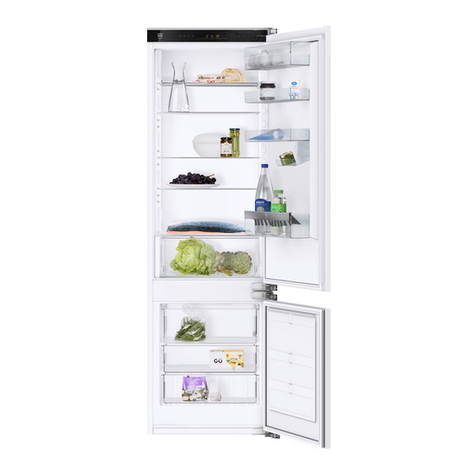
V-ZUG
V-ZUG CombiCooler V4000 operating instructions
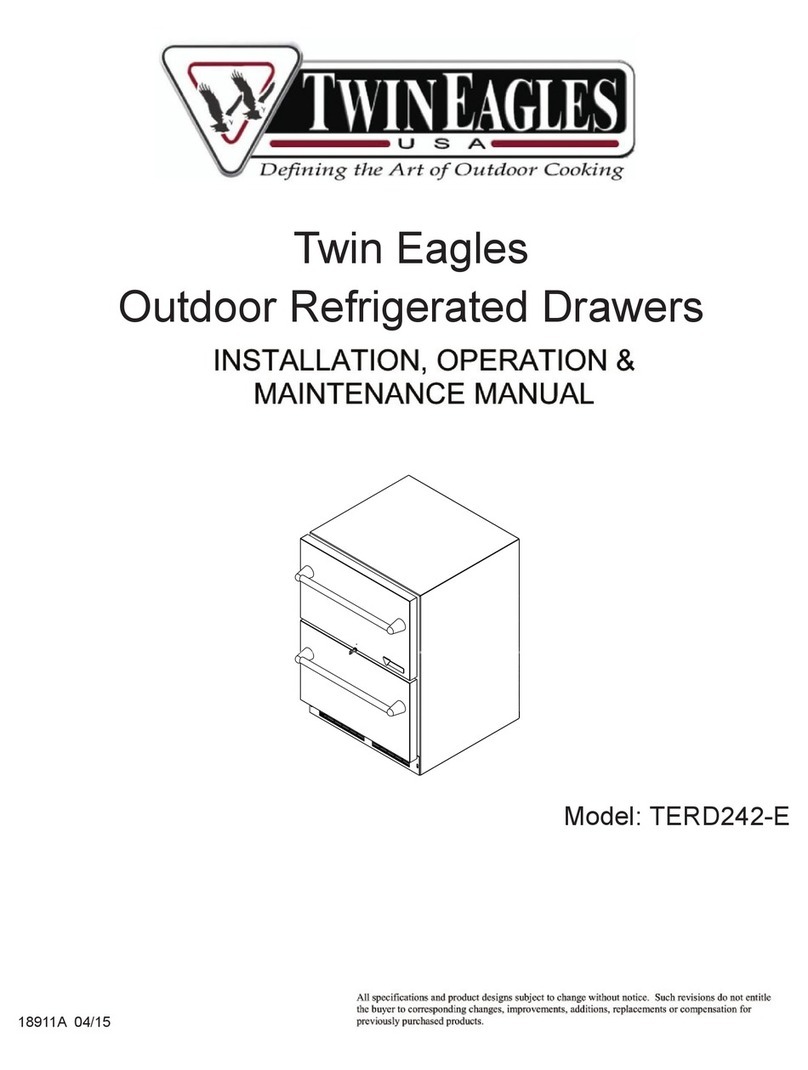
Twin Eagles
Twin Eagles TERD242-E Installation, operation & maintanance manual
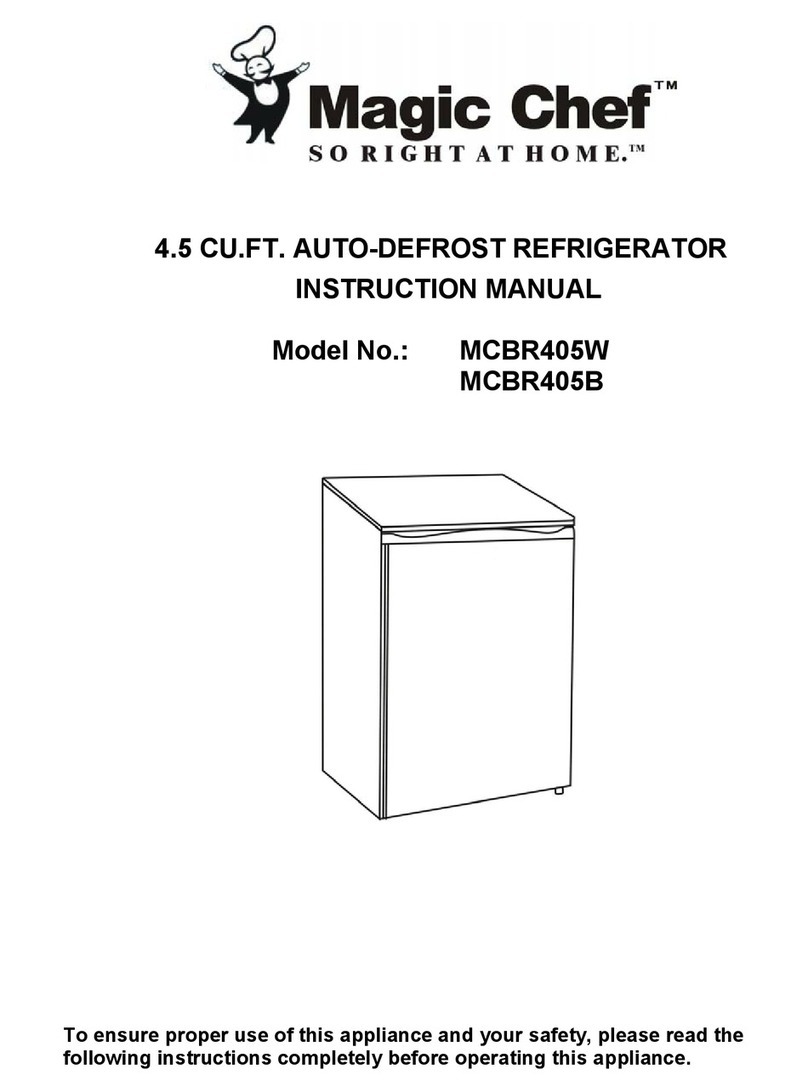
Magic Chef
Magic Chef MCBR405B instruction manual
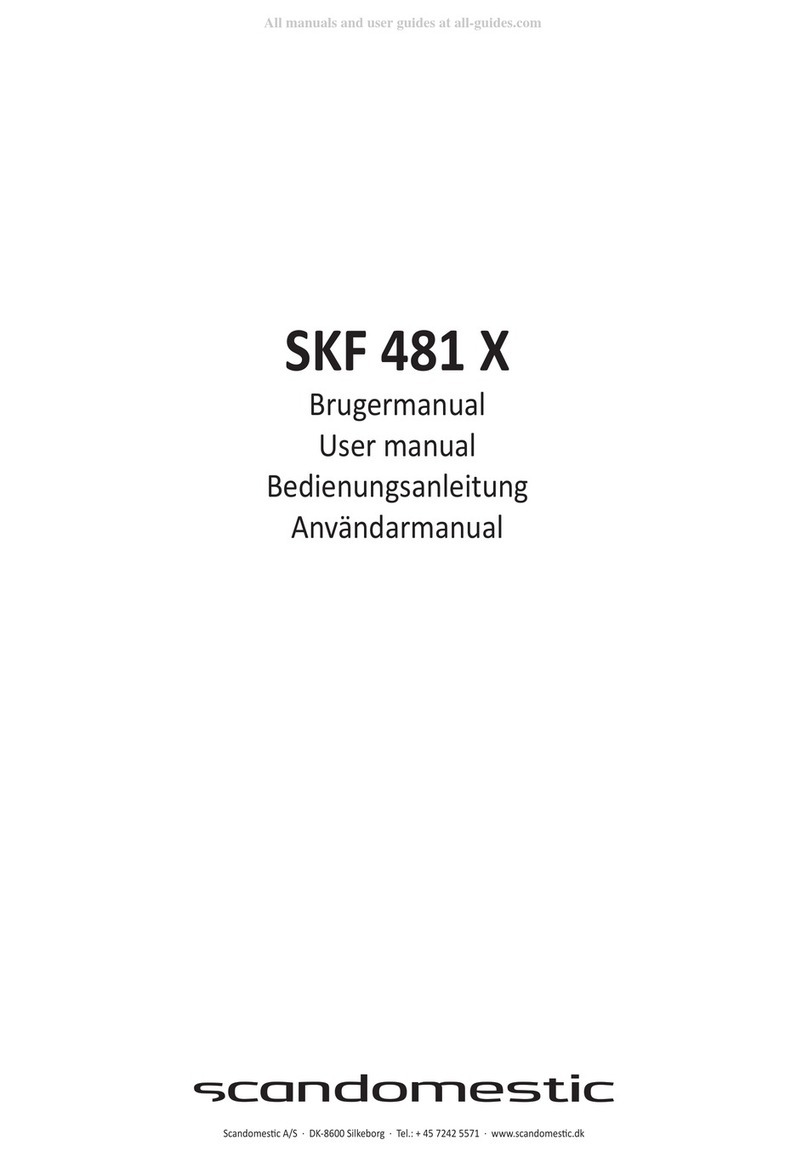
Scandomestic
Scandomestic SKF 481 X user manual
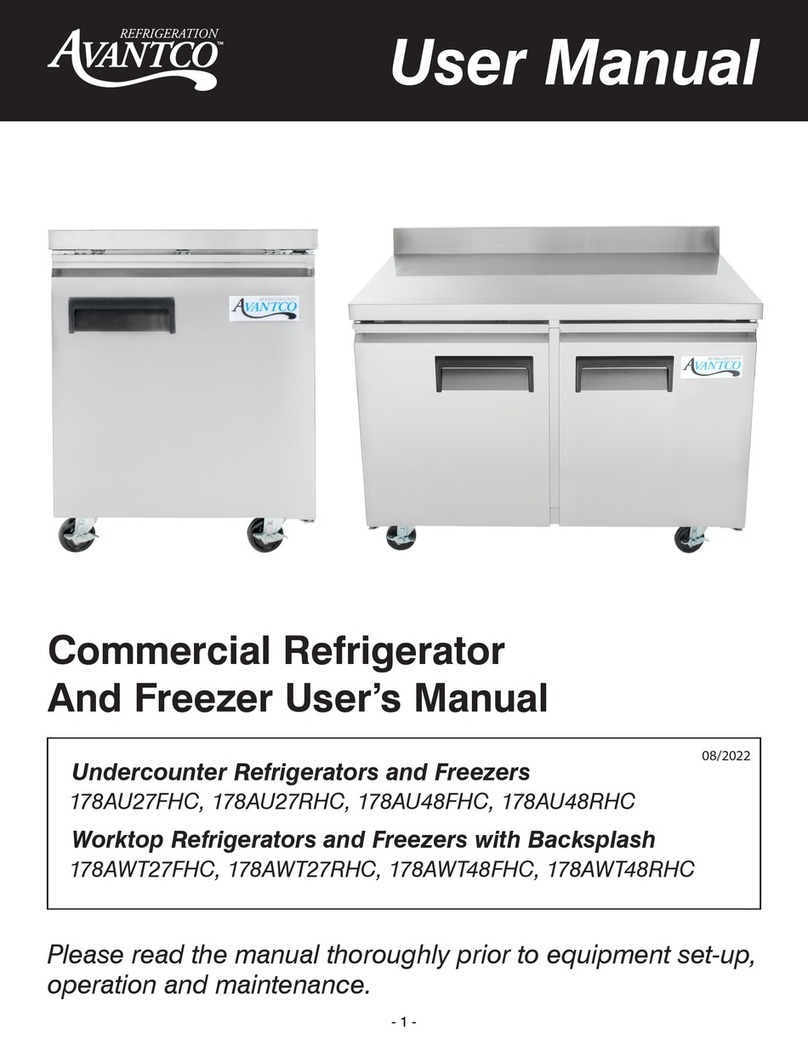
Avantco
Avantco 178AU27FHC user manual
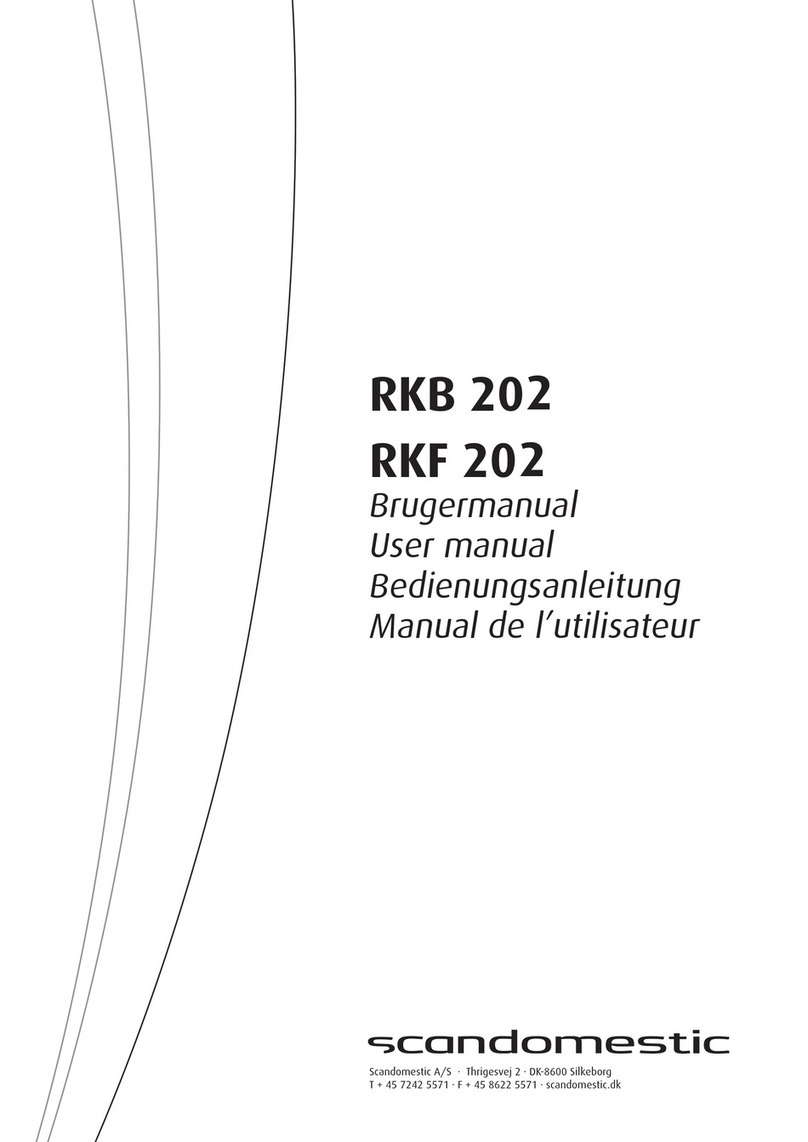
Scandomestic
Scandomestic RKB 202 user manual

